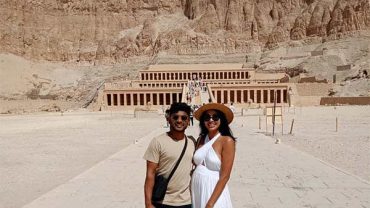The Colossi of Memnon, standing proudly on the West Bank of the Nile River near Luxor, Egypt, are colossal statues that have captured the imagination of travelers and historians alike for centuries. These imposing twin statues, each over 18 meters in height, depict Pharaoh Amenhotep III seated on his throne. The term “Colossi of Memnon” refers to the two massive stone figures that once guarded the entrance to Amenhotep III’s mortuary temple. Despite the passage of more than 3,000 years since their construction, these colossal statues continue to stand as awe-inspiring sentinels of Egypt’s rich and storied past.
The Origin and Purpose
Constructed around 1350 BC during the 18th dynasty of ancient Egypt, the Colossi of Memnon were part of the grandiose mortuary temple dedicated to Amenhotep III, one of Egypt’s most powerful and prosperous pharaohs. The purpose of these statues was not only to immortalize the pharaoh but also to serve as guardians of his funerary complex. The sheer scale of these statues was meant to convey the might and divinity of Amenhotep III, reinforcing the religious and political ideologies of the time.
Over the centuries, the mortuary temple itself fell victim to natural disasters and human intervention, leaving only the two colossal statues standing. Despite the temple’s decline, the Colossi of Memnon have endured, becoming iconic symbols of ancient Egyptian artistry and engineering prowess.
Architectural Marvels
The Colossi of Memnon are made from massive blocks of quartzite sandstone, transported from quarries in Cairo, approximately 700 kilometers away. The precision and skill with which these statues were carved is a testament to the advanced architectural techniques employed by ancient Egyptian craftsmen. The attention to detail in Amenhotep III’s facial features, the intricate carvings on the throne, and the hieroglyphics that adorned the statues all speak to the mastery of the artisans who created them.
Despite their massive size, the Colossi of Memnon also display a sense of artistic finesse, blending aesthetics with functionality. The statues were strategically placed to align with the rising sun, adding a spiritual dimension to their colossal presence. Visitors to the site can still witness the breathtaking sight of the first rays of sunlight illuminating the eastern statue, creating a captivating play of light and shadow.
Mystique and Mythology
Throughout the ages, the Colossi of Memnon have been shrouded in mystique and surrounded by folklore. The most famous legend associated with these statues involves the “singing” of one of the colossi at dawn. Ancient Greek and Roman travelers reported hearing melodious sounds emanating from the northern statue, believed to be the voice of Memnon, a mythical Ethiopian king and son of the goddess Eos. While modern science attributes these sounds to the expansion of the stone as it warmed in the morning sun, the legend adds an enchanting layer to the allure of the Colossi of Memnon.
Preservation Efforts and Tourism
In recent years, concerted efforts have been made to preserve and protect the Colossi of Memnon from the effects of weathering and human activity. Conservation projects aim to ensure that future generations can continue to marvel at these ancient wonders. The site has also become a popular destination for tourists from around the world, contributing to the local economy and fostering a greater appreciation for Egypt’s cultural heritage.
Cultural Significance and Symbolism
Beyond their architectural significance, the Colossi of Memnon hold a profound cultural and symbolic value for the Egyptian people. They represent a tangible link to a bygone era, a time when pharaohs ruled the land, and monumental structures were erected in their honor. These statues serve as enduring symbols of the spiritual beliefs and societal norms of ancient Egypt, shedding light on the importance of religion, power, and the afterlife in shaping the culture of that time.
The seated posture of Pharaoh Amenhotep III in the Colossi not only reflects the regality of the ruler but also conveys a sense of eternal calm and authority. The colossal scale and meticulous craftsmanship were intentional choices to convey the divinity of the pharaoh. This symbolism extends beyond the individual ruler to embody the strength and stability of the Egyptian civilization itself.
Ongoing Discoveries and Research
While much is known about the Colossi of Memnon, ongoing archaeological research and technological advancements continue to unveil new facets of their history. Excavations around the site have revealed additional structures and artifacts, providing valuable insights into the layout and purpose of the original mortuary temple. Modern techniques such as ground-penetrating radar and 3D modeling are aiding scholars in reconstructing the temple’s complex architecture and understanding its role in the religious practices of ancient Egyptians.
These discoveries contribute to a deeper understanding of the socio-religious context in which the Colossi were created. They also highlight the collaborative efforts between international archaeologists and local authorities to preserve and investigate Egypt’s cultural heritage, fostering a sense of shared responsibility for these ancient wonders.
Tourist Impact and Global Connection
As tourism to Egypt continues to grow, the Colossi of Memnon play a pivotal role in attracting visitors from across the globe. The site’s popularity is not only a testament to the enduring appeal of ancient Egyptian history but also fosters cultural exchange and understanding. Tourists, historians, and scholars alike are drawn to Luxor to witness the magnificence of these statues, contributing to the economic development of the region and promoting cross-cultural appreciation.
The Colossi of Memnon serve as ambassadors of Egypt’s rich heritage, inviting people to explore the mysteries of the past and fostering a sense of connection between modern society and the ancient world. Their continued presence in the cultural consciousness speaks to the timeless fascination humans have with the marvels of antiquity.




Comment (0)